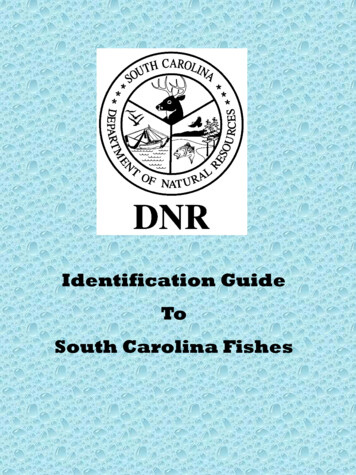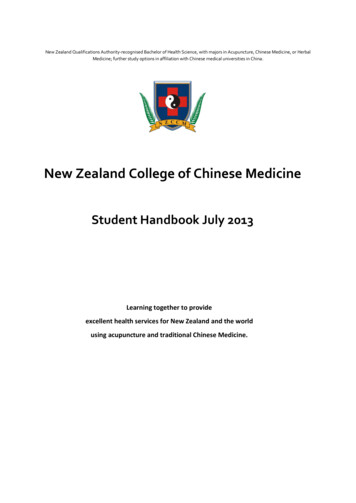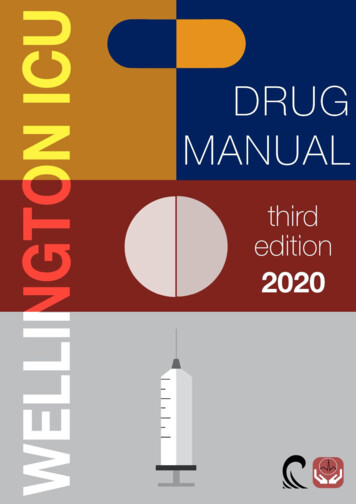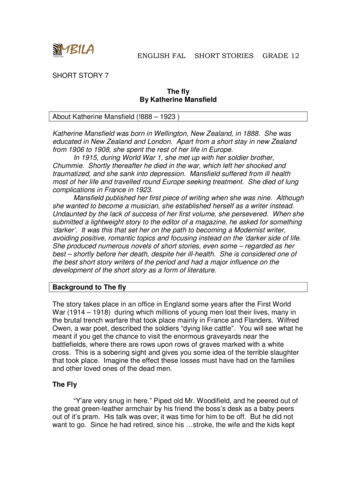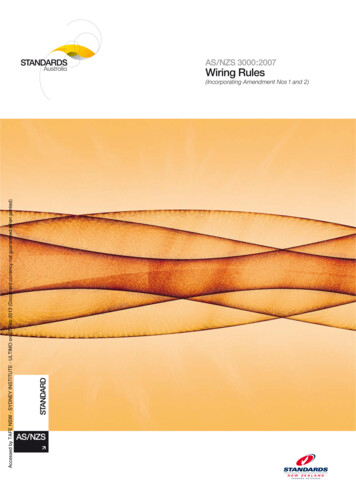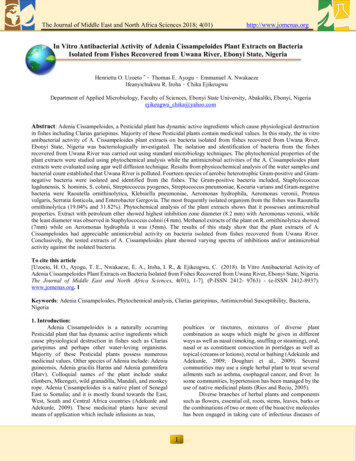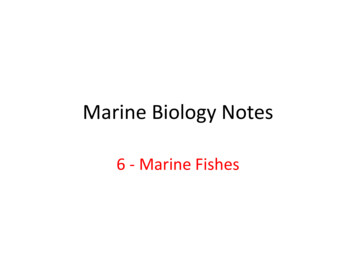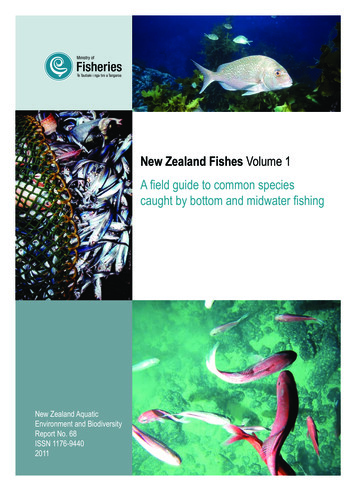
Transcription
New Zealand Fishes Volume 1A field guide to common speciescaught by bottom and midwater fishingNew Zealand AquaticEnvironment and BiodiversityReport No. 68ISSN 1176-94402011
Cover photos:Top – Snapper (Pagrus auratus), Malcolm Francis.Centre – Catch of hoki (Macruronus novaezelandiae), Neil Bagley (NIWA).Bottom – Orange roughy (Hoplostethus atlanticus), NIWA.
New Zealand fishes. Volume 1: A field guide to common speciescaught by bottom and midwater fishingP. J. McMillanM. P. FrancisG. D. JamesL. J. PaulP. J. MarriottE. MackayB. A. WoodL. H. GriggsH. SuiF. WeiNIWAPrivate Bag 14901Wellington 6241New Zealand Aquatic Environment and Biodiversity Report No. 682011
Published by Ministry of FisheriesWellington2011ISSN 1176-9440 Ministry of Fisheries2011McMillan, P.J.; Francis, M.P.; James, G.D.; Paul, L.J.; Marriott, P.J;Mackay, E.; Wood, B.A.; Griggs, L.H.; Sui, H.; Wei, F. (2011).New Zealand fishes. Volume 1: A field guide to common speciescaught by bottom and midwater fishingNew Zealand Aquatic Environment and Biodiversity Report No. 68.This series continues theMarine Biodiversity Biosecurity Report serieswhich ended with MBBR No. 7 in February 2005.
CONTENTSPAGEPurpose of the guide4Organisation of the guide4Methods used for the family and species guides5Data storage and retrieval7Acknowledgments7Section 1: External features of fishes and glossary9Section 2: Guide to families15Section 3: Guide to species33Section 4: References287Index 1 – Alphabetical list of family scientific names301Index 2 – Alphabetical list of family common names303Index 3 – Alphabetical list of species scientific names305Index 4 – Alphabetical list of species common names311Index 5 – Alphabetical list of species MFish research codes317Index 6 – Alphabetical list of species MFish reporting codes323329Appendix 1Instructions for photography and collecting specimens at sea for observers andresearchersDISCLAIMERThis photographic field guide to New Zealand fishes has been developed from themost up-to-date information available to the Ministry of Fisheries at the time ofpublication and includes species commonly caught by trawling, but also some thatmay be caught by other methods such as bottom longline. The taxonomic status andnaming of species, the adoption of species into the Quota Management System(QMS), and the modification of species and reporting codes are ongoing processesthat will continue to change after publication. This field guide is therefore not the soledefinitive source for compliance or taxonomic purposes, and the guide does not affectthe species names and codes provided in legislation. For further guidance on theidentification of fish species or any other information contained in this guide, or ifyou find any information you believe may be inaccurate, please contact Ministry ofFisheries Chief Scientist, pamela.mace@fish.govt.nz.
PURPOSE OF THE GUIDEThis guide to identification of the more commonly caught bottom and midwater New Zealandfishes is intended for field use by non-specialists fishers, fisheries observers, and others. Asecond guide deals with fishes commonly caught by surface fishing, and a third guide coverssome less commonly caught bottom and midwater fishes. Technical terms are kept to aminimum, and identification features are mostly those that can be readily observed on freshlycaught specimens without dissection or microscopic examination. The guide covers 252species from 97 families, including hagfishes, cartilaginous (chimaeras, sharks, skates, andrays) and bony teleost fishes. It includes species that are commonly caught and sold, i.e.,“commercial”, as well as those that are not, i.e., “non-commercial”. For each species there isan annotated colour image or line drawing of the fish to illustrate distinguishing features, aNew Zealand distribution map, and text covering distinguishing features, colour, size,distribution, depth, similar species, biology and ecology, and references. This is the firstedition of this field guide. Further editions will be published as new information accumulates.Ready identification in the field is important for reporting fish catches, the analysis of fishdistribution, abundance and ecology, for fisheries management, and for assessment ofbiodiversity. Field guides are not however a substitute for more comprehensive taxonomicguides where identification remains uncertain. There are several additional identificationguides to New Zealand fishes that can be consulted. The most comprehensive New Zealandfishes identification guide available (Paulin et al. 1989) covers 1008 species but is nowoutdated for some species and is in the process of republication by Museum of New ZealandTe Papa Tongarewa. Some other New Zealand species identification guides include: Paul(2000) covers about 265 marine fishes or groups of fishes with some colour images and smallline drawings, Francis (2001) lists 171 coastal species including a colour image, HirtChabbert (2006) covers 110 of the main commercial species including a colour image, andBanks et al. (2007) cover and illustrate about 80 of the main commercial species ofcartilaginous and bony fishes. The expansion of deepwater commercial fishing in NewZealand in the 1980s resulted in increased fisheries research and specimen collecting.Consequently our knowledge of some groups of fishes, e.g., rattails, ghost sharks andshortnose chimaeras, has expanded considerably over recent years and it is now possible tocompile a guide to the common species in these groups.ORGANISATION OF THE GUIDEThe guide has four main sections.1. External features of fishes. Illustrations of some of the technical terms used to identifyfishes are provided as an introduction to the main identification sections.2. Guide to families. Recognising the family to which a species belongs is often the first stepin identification. The family guide provides distinguishing features for each of the familiescovered here, plus a small image of an example species from each family.3. Guide to species. This section makes up most of the guide, and consists of detailed speciesaccounts.4
4. References, and indexes for species common and scientific names, Ministry of Fisheriesthree-letter reporting and research codes, and family common and scientific names.METHODS USED FOR THE FAMILY AND SPECIES GUIDES(a)Guide to familiesFamilies are arranged in taxonomic order following Nelson (2006) “Fishes of the World”, sofor example the first family listed is the hagfishes (Myxinidae), a group of primitive jaw-lessfishes. Family scientific names and most of the family common names are also taken fromNelson (2006). Family names are also numbered using the numbers in Nelson (2006) to aidlocating the relevant part of the species guide. The text listing the distinguishing features foreach family was adapted mainly from Carpenter & Niem (1998, 1999, 2001), Gomon et al.(2008), and Nelson (2006). An „example species‟ image for each family is provided as aquick visual guide to general body shape, although naturally there is considerable variationwithin a family. We have followed other researchers who have elevated subfamilies to familylevel in two cases. We use Narkidae as a family and have numbered it 43b, compared withNelson (2006) who listed it as a subfamily of 43 Narcinidae. We also use Rajidae 48a andArhynchobatidae 48b as families rather than the subfamilies of Nelson (2006). We followNelson (2006) who treats the rhombosoleid flounders as a separate family 497Rhombosoleidae, distinct from the righteye flounders 493 Pleuronectidae. We follow Nelson(2006) and Eschmeyer (2008) and retain Cheilodactylidae (morwongs) and Latridae(trumpeters) as separate families, but note that Burridge & Smolenski (2004) recommendedthat cheilodactylids (except for two South African species) be placed in the Latridae.(b)Guide to speciesSpecies within each family are arranged alphabetically by scientific name, i.e., by genusname then by species name. Selection of species for this guide was mainly based on thenumber of captures in an extract of all fishes recorded in the Ministry of Fisheries researchtrawl (trawl) database. Most records were from bottom trawl and the remainder frommidwater trawl. The number of occurrences of each species was ranked from highest tolowest. Available resources limited the number of species included to about 250. Occurrencesof species caught by midwater trawl were also compiled from the Ministry of Fisheriesobserver (obs) database and any additional species frequently caught were added to themaster draft list. This list was then compared with the list of Quota Management Systemspecies in the 2006 plenary report (Ministry of Fisheries, Science Group (Comps.) 2006). Itwas also compared with the list of fishes covered in Anderson et al. (1998), and with themidwater trawl species listed in Bagley et al. (2000). All protected species likely to be caughtby bottom and midwater fishing are included in this guide.The species guide contains the following fields:1.2.Species common name. These were extracted from the Ministry of Fisheries databaseof research species codes. For some species there is no common name and the scientificname is used instead.Species scientific name. These were extracted from the Ministry of Fisheries databaseof research species codes, and were then checked using Eschmeyer (2008) to determineif this was the most recent name, and as a check on spelling. The names of fishes in the5
3.4.5.6.7.8.9.10.11.12.13.14.list compiled by King at al. (2009) were also examined for any other changes. In somecases the individual researchers preparing the species accounts for this guide madedecisions about the appropriate scientific name based on their own knowledge of theliterature, and in some cases these names differ from those used by Eschmeyer (2008).A number of species require further taxonomic study to establish their valid scientificname.Family scientific name. Eschmeyer (2008) and Nelson (2006) were used as the sourceof most family names, but in a few cases individual researchers used their ownknowledge of the recent literature to establish the family name. Family name numberswere largely those of Nelson (2006) supplemented by 'a' or 'b' where subfamilies listedby Nelson (2006) were elevated to family in the guide.Family common name. Mostly from Nelson (2006).Maori names. Anon (1995) and Strickland (1990). Many species may have more thanone name depending on the region because iwi (tribes) may use different names, andthere may also be names for some young stages. n.a. indicates that we were unable tolocate a Maori name.Other names. Other common names used in New Zealand and overseas. n.a. indicatesthat we were unable to locate another relevant common name.Ministry of Fisheries reporting code. MFish supplied a list of three letter codes usedin QMS reporting. In some cases the codes differ for different form types, e.g., sandflounder catch would be recorded as SFL on the effort part of the return and FLA on thelanding part.Ministry of Fisheries research code. Three letter codes used for research surveys. Insome cases these differ from the QMS reporting codes; and in particular, theydistinguish related species.Species image. Where possible a new colour image of each species was taken andadjusted, sized and annotated with the principal distinguishing features and a size scale.Many of these images were taken specifically for this project during research surveys.Good specimens were selected from the catch, washed, fins and other structures pinnedout on a polystyrene board, and painted with concentrated formalin. Images werecaptured using a digital SLR camera using photographic lights on a dove greybackground. In some cases images had to be sourced from specimens that werepurchased or caught locally, and from previous photographs sourced from inside andoutside NIWA. In a few cases no suitable image could be obtained and a simple linedrawing was prepared.Distinguishing features. The main features that distinguish the species are provided.Colour. The colours of live or freshly caught fish are described.Size. The approximate maximum size was obtained from research length records andliterature sources. FL fork length, TL total length, SL standard length, all incentimetres.Distribution – text. Based on literature records of the species from New Zealand andoverseas, with comments on the fisheries data records.Distribution – map. Maps were prepared using position data from research survey andcommercial fisheries records, and are therefore not verified with museum voucherspecimens. Most species in this guide are caught by trawling and therefore the uniquestart position (latitude and longitude) of the tow where one or more specimens weretaken was extracted from the trawl database and plotted. Some of the species are alsotaken using surface fishing methods and for those the latitude and longitude where thespecies was captured or observed were extracted from the tuna longline (l line), aerialsightings (aer sight), and tagging (tag) databases and these records plus the trawl6
records were plotted on the map. For l line the unique start position of the longline setwhere one or more specimens were taken was plotted. For aer sight the position wherethe species was observed and identified from the air was plotted. For tag, the releasesite for species identified and tagged was plotted. These maps are therefore anindication of where the species has been reported as caught or sighted in the past, andthey are not meant to be a definitive New Zealand distribution. Red dots show thecapture location, and the EEZ boundary and 1000 m contour are also plotted. Similarmaps were produced by Anderson et al. (1998) and Bagley et al. (2000).15. Depth. The commonly encountered depth range (m) from fisheries and literaturerecords is listed, rather than the extreme depth records.16. Similar species. The distinguishing features of similar species are given to enablecomparison with the species initially identified. Similar species include many that arenot covered in this guide.17. Biology and ecology. Data on mode of life such as spawning season, area, behaviour,feeding are given where these are known.18. References. The literature used to compile the record is listed alphabetically by author(year). The full references (author, year, title, journal, book, etc) are listed at the end ofthe species guide.DATA STORAGE AND RETRIEVALText, distribution maps, and images for this guide are stored in a relational database (Species)created and maintained by NIWA. A web application built on top of the database allows thestored data to be retrieved in a specified format; the report that generates each speciesidentification sheet was designed specifically for this project. Its advantages include easyediting of text or images and distribution maps, addition of new fields or tables, addition ordeletion of species, and on-line access to the database.Requests for access to Ministry of Fisheries databases can be made throughRDM@fish.govt.nz. Note that all observer databases referred to in this document are nowstored in the Centralised Observer Database (COD).ACKNOWLEDGMENTSFunding to produce this guide was provided by the Ministry of Fisheries under researchproject IDG200601. Dr M. E. Livingston supervised the project and along with K. George, A.Martin and A. Hill (all MFish) provided advice on the requirements for the guide. NIWAfunded the purchase of specialised photographic gear for specimen photography and alsofunded time at sea for P. Marriott and P. McMillan to take specimen photographs. N. Bagley,W. Lyons, K. Michael, D. Stevens, M. Stevenson, and C. Sutton, (all NIWA) helped withobtaining specimens, photographing specimens, and supplying photographs. Somephotographs were kindly supplied by K. Graham, R. Kuiter, and C. Duffy (Department ofConservation). The following MFish observers supplied photographs: R. Hanson (makoshark), C. Reid (Ray‟s bream), A. Watson (big-scale pomfret, southern bluefin tuna), R.Williams (swordfish). O. Anderson and A. Hart (NIWA) helped with selecting data from thetrawl database. D. Tracey provided helpful advice from previous experience producing anidentification guide. Special thanks to A. Stewart (Museum of New Zealand, Te PapaTongarewa) who provided comments in his own time. M. Beardsell edited the guide and S.Singh (both NIWA) compiled the final version.7
8
SECTION 1. EXTERNAL FEATURES OF FISHES
The three illustrations below are labelled to show the principal features of sharks, skates/rays,and bony fishes that are used in their identification.10
GLOSSARYAdapted from May & Maxwell (1986) and Paul (2000).Abdomen. Belly region, containing stomach, intestines and reproductive organs (ovaries,testes).Accessory lateral line. Another lateral line in addition to the main lateral line, usually abovethe main line, and usually only for part of its length.Adipose eyelid. Soft, thick, transparent layer of tissue that partially covers the front and rearof the exposed part of the eye, streamlining the head contour.Adipose fin. Small, soft fleshy fin lacking spines or rays, on the rear part of the body behindthe soft dorsal and sometimes anal fins.Anal fin. Median fin on the underside of the body usually between the anus and the caudalfin.Anterior. Front or head end.Anus. The rear opening of the intestine located on the underside of the body usually just infront of the anal fin in bony fishes.Barbel. Fleshy filament lacking rays or spines, usually located on the head and often sensory.Mostly only one, but there may be several, e.g., hagfish.Benthic. Found at the bottom of the sea.Branchiostegal. Rays and membrane inside and below the gill opening in bony fishes,located on the throat and lower head.Canine tooth. Pointed cone-like tooth used for penetrating or holding prey.Cartilage. Firm elastic tissue. In comparison bone is hard and solid.Caudal. Tail.Caudal peduncle. The part of the body just in front of the caudal fin and behind the rear baseof the anal fin. Often narrow and sometimes bearing lateral (sideways-projecting) keels.Cephalic lobe. A flattened extension or appendage of the head.Chimaera length. Also ghost shark length. The straight line distance from the tip of thesnout to the posterior end of the fin on the dorsal surface of the tail, i.e., excludes thelong tail filament found in many chimaeras and ghost sharks.11
Coastal. Living only in the sea near land, usually over the continental shelf unless this is verywide. The term “inshore” is often applied to the inner part of the coastal zone.Conical. Cone shaped.Continental shelf. Seafloor adjacent to the coast, usually from 0 to about 200 m depth, andof variable width.Continental slope. Seafloor starting at the deep end of the continental shelf at about 200 mand extending down to about 2000 m depth.Ctenoid scale. A scale with fine spines or teeth on the rear surface and/or margin.Cusp. The point or projection on a tooth. Some shark species have a central large cusp andsmaller cusps on each side, i.e., total of three cusps per tooth.Cycloid scale. A scale that is smooth and lacking fine spines or teeth on the rear surfaceand/or margin.Deciduous scale. Scale that is easily removed or rubbed off.Demersal. Living on or near the seafloor.Denticle. Small tooth or tooth-like projection, usually on the body surface. Most sharks haveskin covered with denticles giving a rough texture.Disc. The flattened body of skates and rays consisting of the head, trunk, and enlargedpectoral fins.Disc width. The straight-line distance between the widest points on the disc of skates andrays, measured from wingtip to wingtip.Dorsal. Upper side or surface.Dusky. Slightly dark or greyish in colour.Finlet. A small fin-like structure behind the dorsal and sometimes the anal fins.Fork length (FL). The straight-line distance from the tip of the snout to the fork ("V") of thetail, usually measured for fishes that have a forked tail fin, such as trevally(Pseudocaranx georgianus).Gill raker. A bony tooth-like or brush-like projection on the gill arch, pointing into the throatcavity.Head length (HL). The straight-line distance from the tip of the snout to the rear (mostposterior part) of the bony operculum (gill cover).Interorbital width. The shortest distance between the eyes.Isthmus. Fleshy (often scaled) part of the body on underside of the head that separates theright and left side gill chambers.Lateral line. A row of sensory pores or tubed (pored) scales in the skin, starting behind thehead and running along the side of the body, often near the midline, usually finishing ator near the base of the caudal fin.Maxilla. A bone in the upper jaw located behind and above the other upper jaw bone – thepremaxilla. Often flattened and broad posteriorly.Median fins. Unpaired fins located in the middle of the upper or lower surface of the body,i.e., dorsal (one or more), caudal, and anal fins. In contrast to (see also) paired fins.Midwater. Any part of the water column between the surface and the seafloor.Nape. Upper part of the head behind the eyes.Nictitating membrane. Transparent moveable inner eyelid, found in some sharks.Nostril. Small external opening for the nasal organs (smell, taste) on the head or upper body.Usually paired but sometimes single.Oceanic. Living in the open ocean. “Offshore” is often a comparable term, but can also referto outer shelf waters as well as oceanic waters.Operculum. Large flat bony plate on the side and rear of the head just behind thepreoperculum; together they form the gill cover.12
Paired fins. Fins that are paired and usually located on the sides of the body, i.e., pectoraland pelvic fins. In contrast to (see also) median fins.Papilla. A small fleshy projection. Often found on the head, usually numerous and sensory.Pectoral fin. Large paired fins on the side of the body just behind the gill opening(s). May belost or reduced in some species.Pelagic. Free swimming in the sea, and not usually associated with the seafloor. See alsomidwater.Pelvic fin. Paired fins on the underside of the body and usually behind the pectoral fins. Maybe reduced and located on the throat in some species, e.g., ling (Genypterus blacodes).Alternatively called ventral fin.Photophore. Light-producing organ, usually seen as a small dark spot or spots (sometimesnumerous) on the sides or underside of the body.Pored scale. Also tubed scale. A lateral line scale that is associated with a sensory pore andhas a hole or tube connecting the pore to the sea.Posterior. Rear end.Predorsal. The upper body just in front of the first dorsal fin.Premaxilla. A bone in the upper jaw located in front of and below the other upper jaw bone –the maxilla. Often toothed.Preoperculum. A flat bony plate on the side of the head in front of the operculum.Proboscis. An elongated process on the head.Pyloric caeca (singular is caecum). Small tubes or sacs located at the rear end of thestomach and opening into the gut. Probably provide additional surface area for thedigestion of food.Rostrum (rostral). An extended, or projecting, snout.Scute. Enlarged, thickened scale relative to other body or lateral line scales. Usually arrangedin rows along the body. Can be armed with one or more spines, e.g., John dory (Zeusfaber).Snout. The head in front of the eyes.Spinule. Small spine on the surface of some scales. May have distinctive shapes, e.g., spearlike, cone-like, can be very numerous, and are often arranged in rows.Spiracle. An opening behind the eye in skates, rays, and some sharks, used for maintaining aflow of oxygenated water over the gills when the mouth is closed, e.g., when the fish isresting or slightly buried on the seafloor. See also nostril.Standard length (SL). The straight-line distance from the tip of the snout to the rear end ofthe caudal skeleton (vertebra), usually measured for fishes that have a soft tail fin that iseasily damaged, e.g., black slickhead (Xenodermichthys copei).Striated. Covered in lines, ridges or furrows.Suborbital ridge. The ridge below the eye and running along the head, sometimes from thesnout to near the rear of the lower head. May be armed with scutes or spines.Terminal. Located at the end, e.g., terminal mouth is located at the front of the head asopposed to a sub-terminal mouth which is behind (and below) the tip of the snout.Total length (TL). The straight-line distance from the tip of the snout to the tip of the tail,usually measured for fishes which have a robust tail fin lacking a deep fork, e.g.,hapuku (Polyprion oxygeneios). Used for most sharks.Tubed/tubular scale. Also pored scale. A lateral line scale that is associated with a sensorypore and has a hole or tube connecting the pore to the sea.Tubercle. A projection on the surface of the skin, usually not sensory. See also papilla.Ventral. Lower side or surface.Vomerine teeth. Vomer is a bone on the midline of the roof of the mouth, often near thefront, which may bear teeth.13
14
SECTION 2. GUIDE TO FAMILIES
1. Myxinidae (hagfishes)Eel-like body, 1–16 small gill slits onside of head, skeleton cartilaginous,jawless mouth, degenerate eyes, singlenostril, barbels on snout, no paired fins,median fins without rays, no scales.5. Callorhinchidae (ploughnosechimaeras)Single gill opening, large spine in frontof the first of two dorsal fins, hoeshaped proboscis-like snout6. Rhinochimaeridae (longnosechimaeras)Single gill opening, a large spine infront of the first of two dorsal fins, longpointed snout.7. Chimaeridae (shortnose chimaeras,ratfishes)Single gill opening, a large spine infront of the first of two dorsal fins,short fleshy rounded snout.16. Odontaspididae (sand tiger sharks)Two large similar sized dorsal finswithout spines, anal fin, tail fin lessthan about half body length (excludingtail), 5 long gill openings beforepectoral fin origin, teeth with longcentral an 1 or 2 lateral cusp.20. Alopiidae (thresher sharks)Upper lobe of caudal fin enormouslyenlarged and may exceed body length(excluding tail), very small seconddorsal fin.16
21. Cetorhinidae (basking sharks)Very large gill openings extending ontodorsal and ventral surfaces of head,hair-like gill rakers on gill arches, over200 rows of very small teeth, smallsecond dorsal fin, eyes small, caudal finnearly symmetrical, lateral keel oncaudal peduncle.22. Lamnidae (mackerel sharks, makos,white sharks, porbeagles)Fifth gill slit in front of and extendingbelow pectoral fin origin, minutesecond dorsal fin, eyes lack nictitatingmembrane, lateral keel on caudalpeduncle.23. Scyliorhinidae (cat sharks)Fifth gill slits over or behind pectoralfin origin, small multi-cuspid teeth withseveral series functional, anal fin andspiracle present, caudal fin withoutkeels or pits, caudal fin axis onlyslightly elevated.25. Pseudotriakidae (false cat sharks)First dorsal fin low elongate and keellike, nictitating eyelids rudimentary,spiracles large, very many tooth rows,posterior teeth comb-like.27. Triakidae (hound sharks,smoothhounds, topes)Fifth gill slit over or behind pectoral finorigin, two dorsal fins lacking spines,anal fin present, rear of first dorsal finanterior to pelvic fin origin, seconddorsal fin smaller than first, no keel onside of caudal fin, no precaudal pit.29. Carcharhinidae (requiem sharks)Fifth gill slit over or behind pectoral finorigin, two dorsal fins lacking spines,anal fin present, nictitating membranepresent on eye, teeth blade-like (smallto large), caudal fin stronglyasymmetrical with short lower lobe,precaudal pit present.17
30. Sphyrnidae (hammerhead andbonnethead sharks)Anterior of head much flattened andwidely expanded to form a hammershape with eyes and nostrils at the outeredges.31. Chlamydoselachidae (frill sharks)Six gill openings, margin of first gillcontinuous across throat, mouthterminal, teeth alike on upper and lowerjaws with three long cusps, body veryelongate.32. Hexanchidae (cow sharks, sixgill,and sevengill sharks)Six or seven pairs of long gill slits withthe first pair not connected acrossthroat, single dorsal fin, teeth of upperand lower jaws unlike at sides ofmouth, lower jaw teeth very large,broad, and comb-like.34. Squalidae (dogfish sharks)Five gill slits all anterior to pectoralfins, spiracles always present, eyeswithout nictitating eyelids, two dorsalfins with spines, no anal fin.35. Centrophoridae (gulper sharks)Both dorsal fins with spines and bothspines grooved, no anal fin, teeth onlower jaw larger than those on upperjaw, precaudal pits and lateral keelsabsent on caudal peduncle.36. Etmopteridae (lantern sharks)Both dorsal fins with spines and bothspines grooved, no anal fin, caudal finwith sub-terminal notch.37. Somniosidae (sleeper sharks)Dorsal fins usually without spines, noanal fin, lateral ridge present onabdomen between pectoral and pelvicfins.18
38. Oxynotidae (rough sharks)Body very high and laterallycompressed, triangular in cross section,dorsal fins very high, each with a largespine, no anal fin, lateral ridge presenton abdomen between pectoral andpelvic fins, skin very rough.39. Dalatiidae (kitefin sharks)Dorsal fins without spines, no anal fin.Luminous organs present appearing asblack dots mainly on ventral surface.42. Torpedinidae (torpedo electric rays)Large elliptical disc and stout sharklike tail, body naked above and belowwithout dermal denticles or thorns,mouth broadly arched and broad, firstdorsal fin originates far behind anteriorhalf of total length.43b. Narkidae (sleeper rays)Oval body, naked above and belowwithout dermal denticles or thorns,mouth transverse and straight, firstdorsal fin originates behind anteriorhalf of total length.48a. Rajidae (hardnose skates)Snout supported by stout rostralcartilage in most species, broad discwith narrow slender tail, sharp hookeddenticles or thorns on dorsal surface, nobarbed sting on tail, five small ventralgill open
New Zealand fishes. Volume 1: A field guide to common species caught by bottom and midwater fishing .
